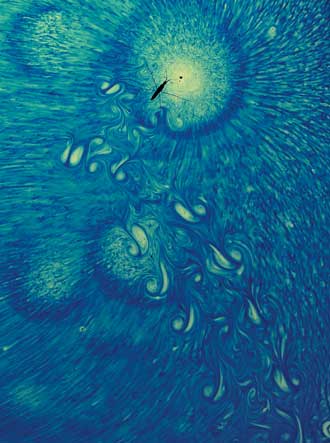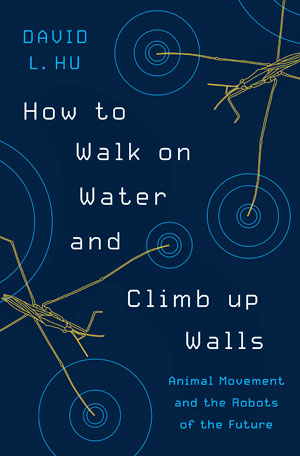
From cave paintings to the anatomical sketches of Leonardo da Vinci, the movement of animals has long fascinated people. Now there is an explosion of new interest and understanding in animal motion. Recent technological developments and the combined interest of computer scientists, physicists, and engineers are enabling us to find new ways to understand how animals can move with such grace and beauty. Understanding how animals move can lead to the development of new kinds of robots and devices, such as crash-resistant drones, robots that walk on water, and exoskeletons that improve the efficiency of walking.
If you have enjoyed watching animals on the Discovery channel, this book will provide a conversational explanation of the things that you see in the show. In the book, I explain the physical principles at work—without it feeling like a full college course.
Understanding animal motion requires application of physics, material science, and robotics.
Take an insect walking on water called the water strider. Its legs are covered in the hairiest surface in the animal kingdom. The 10,000 hairs per square millimeter help trap air bubbles and prevent the legs from getting wet with each stroke. We apply fluid mechanics to understand how the legs can support the strider’s weight and propel it forward. Robotic design is used to build lightweight robots that can walk on water by taking advantage of the size and forces applied by the legs. These robots are given solar panels or other lightweight energy storage devices that enable them to be mass produced and used as cheap ways to monitor the world’s oceans.
When I was a kid I loved going to the zoo and watching animals. When I was admitted to MIT, I learned that the tools of engineering could be useful to understand the amazing things that animals do. I combined this with a PhD in mathematics, and now I run my own laboratory as a professor in both mechanical engineering and biology at Georgia Tech. Our lab studies the design of animals and builds devices based on the things we learn.

The cover of the book is a water strider—an insect that stands on water as if it were land. As the animal rows, it generates waves on the water surface, similar to the ones created when a stone is thrown into a pond. The cover is just the first of several beautiful images featured in the book. The color image section contains a number of award-winning photographs including trout swimming upstream, mosquitoes being struck by raindrops, and ants linking their bodies together to build rafts.
The table of contents includes short striking descriptions of each of the chapters. Swimming under Sand involves the sandfish—a lizard that swims through sand like it is water. Shape of a Flying Snake involves snakes that can spread their ribs like wings to glide through the air. Dead Fish Swimming involves trout that can use their flexible bodies to harvest the energy of rushing rivers so well that even dead fish can swim forward. Are Ants a Fluid or a Solid involves fire ants that can link their bodies together to build waterproof rafts to survive floods. Each of these chapters introduces the physical concepts necessary to understand each of these extraordinary phenomena.
Each chapter introduces the relevant background and can be read independently of the other chapters. I would like the reader to flip through the contents and find a topic that interests them, and then read the chapter. Of course, reading the book from beginning to end works too.
The topics in this book have potential applications in the field of robotics.
Robots have long been relegated to perform repetitive tasks such as assembling parts of a car in factories. In the future, however, robots will leave the factories and enter our everyday lives. Many of the environments that need robots are outdoor environments, such as the open ocean and the sandy surface of Mars. Designing machines to tackle many of these environments can be difficult, due to the physics of the varying medium which still cannot be well predicted on computers.
One shortcut to designing machines that can move with speed and good gas mileage is by looking at how animals move through these environments. To traverse natural terrain, robots may need multiple legs like an insect, or no legs at all like a snake. Robots that successfully traverse outdoor environments are already showing resemblance to the animals that make this place their home. This is because the laws of physics pose unbreakable constraints that influence what kind of motion is most effective.
This book has been a big hit among young audiences. Animal motion is one of the most accessible and interesting subjects around. And it applies to multiple subject areas such as physics, biology, and material science to satisfy anyone’s curiosity. In the book, I spend equal time going through the science behind the discoveries as well as the excitement and thought process of the scientists at work. I hope this book shows that science can be fun and that anyone can be a scientist.


David Hu is a mechanical engineer who studies the interactions of animals with water. He has discovered how dogs shake dry, how insects walk on water, and how eyelashes protect the eyes from drying. Originally from Rockville, Maryland, he earned degrees in mathematics and mechanical engineering from M.I.T., and is now Associate Professor of Mechanical Engineering and Biology and Adjunct Professor of Physics at Georgia Tech. He is a recipient of the National Science Foundation CAREER award for young scientists, the Ig Nobel Prize in Physics, and the Pineapple Science Prize (the Ig Nobel of China). He is the author of the book How to Walk on Water and Climb up Walls. His profile is in the New York Times. And he gave a TEDx talk in 2018. He lives with his wife and two children in Atlanta, Georgia.